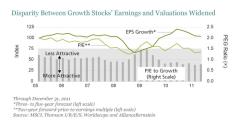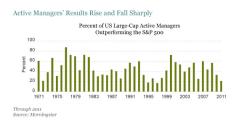This blog is part of a new series on the Institutional Investor website entitled Global Market Thought Leaders, a platform that provides analysis, commentary, and insight into global markets and the economy from the researchers and risk-takers at premier financial institutions. Our first contributor in this new section of Institutionalinvestor.com is AllianceBernstein, who will be providing analysis and insight into equities.
Although 2011 was mostly a rough ride for U.S. equity investors, the S&P 500’s 11.8% fourth-quarter gain was enough to move the index into positive territory for the year. The Russell 1000 Growth benchmark ended up for the year as well.
The performance reflects a moderation of fear in the fourth quarter, amid increasing signs of the economy stabilizing in the U.S. and action to contain the debt crisis in Europe. But risk aversion did not evaporate. The so-called equity risk premium, which tends to rise as investors’ willingness to accept risk goes down, remains elevated. In fact, this measure of the potential return on stocks relative to intermediate bonds shows exceptional opportunity for those willing to take on the risk of equities.
We continue to see signs of investors’ unwillingness to put faith in future growth potential. As 2012 earnings forecasts have come down in response to continued murkiness in the business environment, valuation multiples have fallen even faster, reflecting even greater pessimism than the forecasts alone.

Such pricing anomalies provide unusual opportunities for active managers to use in-depth company research to identify stocks likely to confound negative expectations and go on to outperform. But active management itself has been facing skepticism. Increasingly, many investors are questioning active managers’ ability to add value, preferring instead to just mirror equity indexes through passive investing.
There’s no question that active managers’ success has been muted in recent years. For example, a study by Morningstar shows that in 2011 only about 20% of all U.S. large-cap active managers outperformed the S&P 500 Index, one of their lowest annual success rates in 40 years.

But the study also shows that active manager performance can be highly cyclical and can recover very quickly. For example, periods in which 20% or fewer of active growth managers outperformed were often closely followed by years in which 60%, 70% or even higher percentages of active managers beat the broad market.
Given this history, we believe it is premature to write off active management, especially in light of the pricing anomalies in today’s market. In our view, active managers have the greatest flexibility to exploit the huge opportunities available today. The real risk may prove to be leaving this potential on the table.
The views expressed herein do not constitute research, investment advice or trade recommendations and do not necessarily represent the views of all AllianceBernstein portfolio-management teams.
Scott Wallace is the Team Leader — U.S. Large Cap Growth at AllianceBernstein






